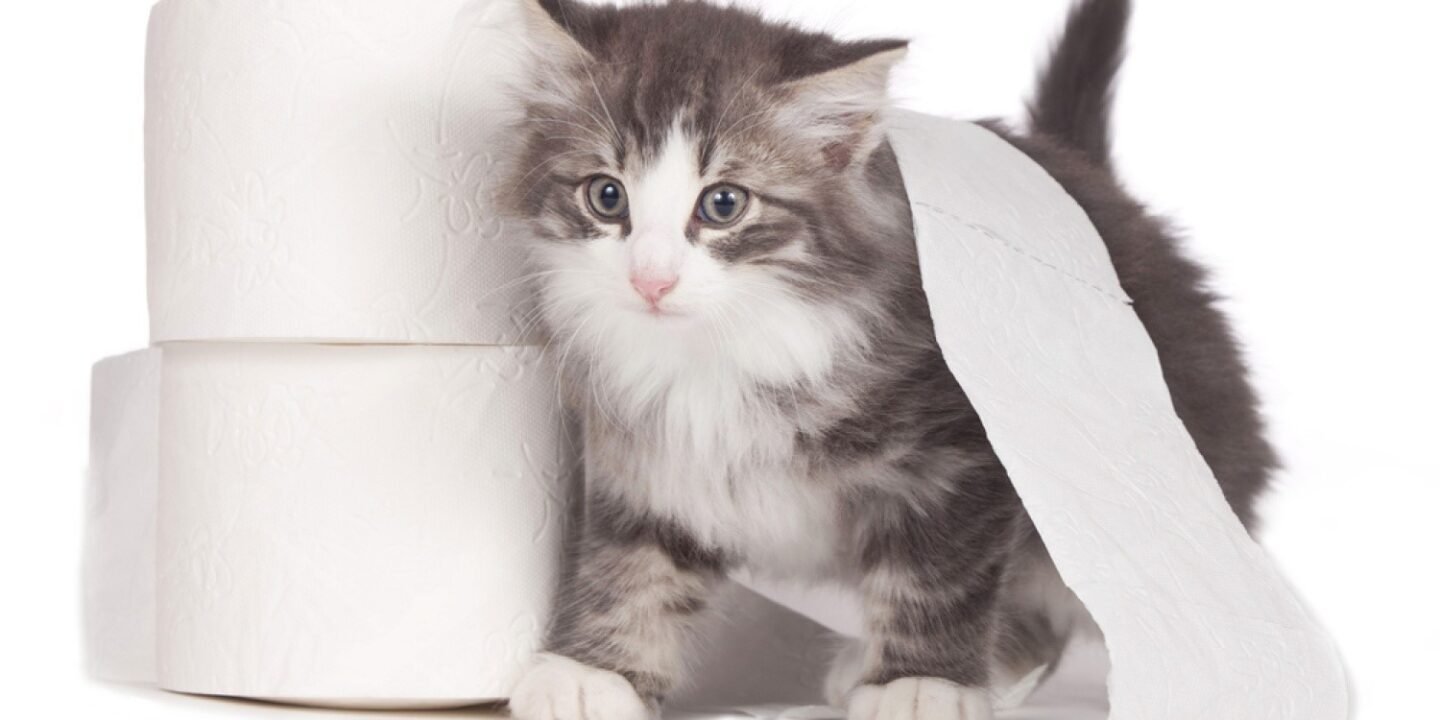When a kitten presents with vomiting and diarrhea, it is always considered a potentially serious medical concern. Unlike adult cats, kittens have very limited reserves of fluid and energy, meaning even a short period of gastrointestinal upset can quickly lead to dehydration, electrolyte imbalance, and life-threatening complications. In practice, veterinarians approach kitten vomiting and diarrhea as an urgent condition that requires rapid assessment of hydration status, infectious disease risk—particularly feline panleukopenia—and the possibility of parasites or dietary causes. For pet owners, recognizing these signs early and knowing when immediate veterinary care is warranted can make the difference between a straightforward recovery and a critical emergency.
Why Vomiting and Diarrhea in Kittens Is Serious
Kittens are not small versions of adult cats—they are far more fragile and medically vulnerable. Gastrointestinal upset in this age group is never taken lightly for several reasons:
- Rapid fluid and electrolyte loss
Kittens have a much smaller fluid reserve compared to adult cats. Even mild vomiting and diarrhea can cause significant dehydration within hours. Along with water loss, electrolytes such as sodium, potassium, and chloride are depleted, which can quickly disrupt normal heart, muscle, and nerve function.
- High risk of infectious disease
Vomiting and diarrhea are hallmark signs of serious infections in kittens, including feline panleukopenia (feline parvovirus), coccidiosis, and giardiasis. Panleukopenia, in particular is a life-threatening viral disease that progresses rapidly without prompt veterinary care. Because kittens’ immune systems are still immature, they are more susceptible to contracting and developing severe illness from these pathogens.
- Potential for rapid deterioration
Unlike adult cats that may tolerate mild gastrointestinal upset for a short period, kittens can decline quickly. Ongoing fluid loss combined with an inability to maintain nutrition may result in hypoglycemia (dangerously low blood sugar), weakness, and eventually shock. Without intervention, this can be fatal.
- Increased vulnerability in unvaccinated kittens
Kittens that have not yet completed their initial vaccine series are at particularly high risk. Exposure to contaminated environments, other cats, or even shared food and water bowls can be enough to transmit infectious agents that cause vomiting and diarrhea.
Clinical takeaway: Any episode of vomiting and diarrhea in a kitten should be treated as a medical concern requiring prompt veterinary evaluation. Early recognition and timely treatment are critical to prevent life-threatening complications.
Clinical Signs to Watch Closely
As a veterinarian, when evaluating a kitten with vomiting and diarrhea, these are the key clinical signs I assess immediately—each one essential to determine severity and guide further action:
Frequency & Appearance of Vomit/Stool
- Frequency: Multiple episodes within a few hours may signal severe fluid loss.
- Appearance:
- Blood (either fresh red or tarry black) suggests serious GI compromise and warrants urgent evaluation.
- Bile-tinged (yellow or green) or watery stool raises concerns for bile reflux or small-intestinal involvement.
- Visible worms frequently imply a parasitic infestation.
- Foul-smelling or malodorous stool often indicates malabsorption or infection.
Cornell Vet MedicinePurinaThe Spruce Pets
General Demeanor
Hydration Status
Assess hydration by evaluating:
- Gums: Dry, tacky, or sunken pink mucous membranes are warning signs.
PurinaPetMD
- Skin elasticity (“skin-tent”): Gently pinch the skin over the shoulder blades—delayed return (a tent lasting longer than 1–2 seconds) is consistent with dehydration.
PurinaPets Furst Urgent CareThe Spruce Pets
- Urine output: Reduced urination frequency or dark, concentrated urine reflects a fluid deficit. Though harder for owners to track, it’s a vital hydration clue.
Weight Loss or Failure to Thrive (Neonates)
- Weight loss or failure to gain is especially grave in neonates and young kittens; even minor daily weight loss can reflect significant risk.
- Consistent monitoring (daily gram-scale weights) is a key part of neonatal care.
Veterinary Wellness ClinicHumanePro
Summary for Veterinary Application
| Sign |
Interpretation |
| Frequent episodes |
Risk of rapid dehydration |
| Blood in vomit/stool |
Severe GI disturbance—urgent attention |
| Lethargy |
Possible systemic or metabolic compromise |
| Dry, tacky gums |
Significant fluid loss |
| Prolonged skin-tent |
Moderate to severe dehydration |
| Weight loss/failure to gain |
Red flag, especially in neonates |
Recognizing these clinical signs allows a veterinarian to differentiate between kittens that can be stabilized at home briefly and those requiring immediate intervention—such as IV or subcutaneous fluids, diagnostics, or in-hospital monitoring.
When to Seek Immediate Veterinary Attention
Vomiting and diarrhea in kittens should never be ignored, but certain warning signs indicate the need for urgent veterinary care:
- Blood in vomit or diarrhea – The presence of blood suggests gastrointestinal bleeding, which may result from viral infection (such as feline panleukopenia), parasites, toxin ingestion, or severe inflammation. This is a red-flag emergency that requires prompt diagnosis and stabilization.
- Repeated vomiting or inability to keep fluids down – Persistent vomiting prevents adequate hydration and nutrient absorption. In young kittens, this can rapidly lead to electrolyte imbalances and hypoglycemia. Veterinary intervention is necessary to administer fluids and anti-nausea therapy.
- Severe lethargy, collapse, or refusal to nurse/eat – Healthy kittens are typically active and eager to feed. A sudden drop in energy or refusal to nurse may indicate systemic illness or shock. Immediate supportive care is crucial.
- Fever or painful abdomen – Fever can signal infection or inflammation, while abdominal pain may indicate intestinal obstruction, intussusception, or peritonitis. Both are medical emergencies in fragile kittens.
- Unvaccinated kittens with vomiting and diarrhea – These signs in an unvaccinated kitten must raise strong concern for feline panleukopenia (feline distemper), a highly contagious and often fatal viral disease. Rapid testing and aggressive supportive care are required.
- Kittens under 12 weeks with any persistent vomiting or diarrhea – Because neonates and young kittens lack mature immune and metabolic reserves, even mild-seeming symptoms can escalate quickly to life-threatening dehydration or hypoglycemia.
⚠️ Bottom line: Any kitten under 12 weeks showing these warning signs must be evaluated by a veterinarian immediately. Early treatment can mean the difference between recovery and a fatal outcome.
Common Causes of Vomiting and Diarrhea in Kittens
Infectious Causes
Feline Panleukopenia Virus (FPV / Feline Parvovirus):
Panleukopenia is one of the most dangerous infectious diseases in kittens. It is highly contagious, transmitted through contaminated feces, environments, or even on human clothing, and can survive for months in the environment. Clinical signs include sudden onset of severe vomiting, diarrhea (often bloody), profound lethargy, dehydration, and fever. Mortality rates are very high in unvaccinated kittens, and survival depends on immediate supportive care (IV fluids, antiemetics, and antibiotics to prevent secondary infections). Vaccination is the most effective prevention strategy.
Intestinal Parasites:
Parasitic infections are another frequent cause of gastrointestinal illness in kittens, especially those from shelters, outdoor environments, or with unknown deworming histories.
- Roundworms (Toxocara cati) are extremely common and can cause vomiting, diarrhea, poor growth, and even visible worms in stool or vomit.
- Hookworms can lead to bloody diarrhea, anemia, and rapid deterioration.
- Coccidia and Giardia are protozoan parasites that cause watery, foul-smelling diarrhea, sometimes accompanied by mucus. These infections spread easily in multi-cat settings and require specific anti-parasitic treatment beyond routine dewormers.
Bacterial Infections:
Though less common than viral or parasitic causes, bacterial pathogens can cause severe gastrointestinal disease in kittens.
- Salmonella and E. coli infections are often linked to contaminated raw diets, spoiled food, or unhygienic environments. Signs may include vomiting, watery or bloody diarrhea, abdominal pain, and systemic illness (fever, septicemia).
- Young kittens are particularly vulnerable due to their underdeveloped immune systems, and these infections can quickly become life-threatening. Prompt diagnosis through fecal testing and bacterial culture is essential, followed by targeted antibiotic therapy when indicated.
👉 Infectious causes are medical emergencies in kittens. Early detection, diagnostic testing, and aggressive supportive care significantly improve survival outcomes.
Nutritional and Dietary Causes
Sudden diet changes
Kittens have delicate digestive systems, and abrupt changes in food can trigger gastrointestinal upset. Even shifting from one commercial kitten food to another without a gradual transition may lead to vomiting or diarrhea (Cornell Feline Health Center, 2023). A transition period of 7–10 days is generally advised, mixing the old and new food in increasing ratios.
Feeding inappropriate foods
Cow’s milk, fatty foods, or table scraps are common culprits. Contrary to popular belief, most kittens are lactose intolerant; the lactose in cow’s milk is poorly digested, leading to diarrhea and bloating (ASPCA, 2023). Rich or fatty human foods can overwhelm the kitten’s digestive enzymes, causing pancreatitis or persistent gastrointestinal upset.
Formula preparation errors in bottle-fed kittens
For orphaned kittens, improper formula preparation—whether incorrect dilution, temperature errors, or unsafe ingredients—can directly result in vomiting, diarrhea, and dehydration (American Veterinary Medical Association [AVMA], 2023). Only commercial kitten milk replacer (KMR) is recommended; homemade substitutes or cow’s/goat’s milk lack essential nutrients and pose digestive risks.
Other Causes
Foreign body ingestion
Kittens are naturally curious and prone to chewing or swallowing non-food objects such as string, rubber bands, toys, or even litter. These can cause intestinal blockage or irritation, leading to repeated vomiting, diarrhea, or both. In some cases, surgery is required to remove the obstruction (VCA Animal Hospitals, 2023).
Toxin exposure
Household plants (e.g., lilies), cleaning chemicals, and certain medications (such as acetaminophen or ibuprofen) are toxic to cats. Ingestion can lead to acute vomiting, diarrhea, and systemic signs such as lethargy, drooling, or organ failure (Pet Poison Helpline, 2023). Even small amounts may be life-threatening for kittens due to their small body mass.
Underlying systemic illness
Vomiting and diarrhea may not always be localized to the stomach or intestines. Conditions such as congenital liver shunts, pancreatic disorders, or metabolic diseases can manifest as gastrointestinal upset in kittens. Identifying these requires veterinary diagnostics like bloodwork, imaging, and sometimes specialist referral (Cornell Feline Health Center, 2023).
Safe Supportive Care at Home
While veterinary evaluation is always the gold standard when kittens show vomiting or diarrhea, certain safe supportive measures may be used at home until professional care is reached. These steps should never replace a proper medical work-up, but can help stabilize your kitten and prevent worsening illness.
Hydration monitoring: Watch closely for signs of dehydration, such as sticky gums, skin tenting, or reduced urination. If your kitten is not vomiting plain water, you may offer very small sips of fresh water or a veterinary-approved oral electrolyte solution. Never force-feed fluids, as this may trigger aspiration.
Food: For kittens old enough to eat solid food, withhold food for 2–4 hours after vomiting to allow the stomach to settle (do not fast neonates, as they require constant nutrition). After the brief rest period, reintroduce small amounts of bland, easily digestible food such as a veterinary recovery diet or plain boiled chicken with rice. Feed gradually and in tiny portions to avoid overloading the stomach.
Bottle-fed kittens: Double-check formula preparation to ensure it is properly mixed—not too concentrated or diluted. Feed at the correct intervals for the kitten’s age, and confirm that the bottle nipple flow rate is appropriate (too fast can cause aspiration, too slow may cause frustration and overfeeding attempts).
Isolation and hygiene: If multiple cats or kittens are present, separate the sick kitten to prevent potential spread of infection. Use gloves when cleaning litter boxes or handling vomit/diarrhea, and disinfect contaminated surfaces with veterinary-recommended products (such as diluted bleach solutions) to reduce infectious risk.
⚠️ Important note: These measures are strictly supportive. Vomiting and diarrhea in kittens can escalate rapidly into a life-threatening emergency. Always seek veterinary care promptly to identify and treat the underlying cause.
Preventing Vomiting and Diarrhea in Kittens
The best way to protect your kitten from gastrointestinal illness is through prevention. Many causes of vomiting and diarrhea can be avoided with proper medical care, safe nutrition, and a clean living environment.
Vaccination (FVRCP series completed by 16–20 weeks)
The FVRCP vaccine protects kittens from feline panleukopenia (parvovirus), calicivirus, and herpesvirus—three of the most serious and contagious feline diseases. Ensuring your kitten completes the full series by 16–20 weeks provides a strong foundation of immunity.
Routine deworming and fecal exams
Intestinal parasites are a common culprit behind vomiting and diarrhea in kittens. Vets recommend starting deworming as early as 2–3 weeks of age and repeating it at regular intervals, followed by periodic fecal exams to confirm your kitten stays parasite-free.
Proper diet and gradual transitions
Kittens have sensitive digestive systems, and sudden changes in food often lead to stomach upset. Any diet transition—whether to a new brand, flavor, or texture—should be done slowly over 7–10 days by mixing increasing amounts of the new food with the old.
Safe feeding practices for bottle-fed kittens
For orphaned or hand-raised kittens, formula preparation and feeding technique are critical. Always use a kitten-specific formula (never cow’s milk), mix according to instructions, and check nipple flow rate to prevent aspiration or overfeeding. Consistency in the feeding schedule also helps avoid digestive distress.
Environmental hygiene and parasite control
Maintaining a clean home environment reduces the spread of infectious agents. Litter boxes should be scooped daily and disinfected regularly, food and water bowls washed frequently, and bedding kept clean. Using flea prevention and controlling household pests further lowers the risk of parasitic infections.
By staying proactive with veterinary care and creating a safe, hygienic environment, you can significantly reduce the likelihood of vomiting and diarrhea in kittens while supporting healthy growth and development.
Key Takeaways
- Kittens with vomiting and diarrhea need immediate veterinary evaluation.
- Dehydration develops quickly, often within hours.
- Supportive home care helps, but professional treatment is essential for survival.
FAQ’s
Can I give human medications like Pepto-Bismol to my kitten?
No. Human medications such as Pepto-Bismol, ibuprofen, or acetaminophen are unsafe and potentially toxic to cats. Always use only veterinary-prescribed treatments.
How quickly can a kitten become dehydrated?
Very quickly—sometimes within hours. Because kittens are small and their bodies have limited fluid reserves, even mild vomiting or diarrhea can cause severe dehydration in less than a day. Immediate care is critical.
Can vaccinated kittens still get panleukopenia?
It’s rare, but possible. A full vaccine series (FVRCP, completed by 16–20 weeks) provides strong protection, but incomplete vaccinations or exposure before immunity develops can still leave a kitten at risk.
What should I bring to the vet for diagnosis?
Bringing useful information helps speed up diagnosis. Take a fresh stool sample (in a sealed bag), photos or videos of vomit/diarrhea, and a care log that notes feeding, hydration, behavior changes, and when symptoms started.





